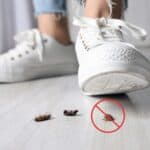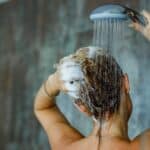In many homes, both new and old, lamps can be statement pieces. This is almost always because of the way the lampshade looks or affects the light coming from within. No home would be complete without a lamp and a cool decorative lampshade. So why is it that the lampshades are so often overlooked during the cleaning process?
No matter what kind of lampshades you have around your home they can, and should, be cleaned and dusted regularly. Below you’ll find our helpful guide to cleaning and caring for the different types of lampshades that you may have around your home. Keep reading to find out how to bring out the best in your home’s lighting!
Before You Get Started
Before the cleaning process begins, you’ll want to make sure you have all the materials you’ll need for the cleaning process. Here are some of the supplies you’ll want to have on hand:
|
|
Dusting your lampshades should be a once-a-week task on your cleaning schedule. But there is more to be done when deep cleaning and properly washing your lampshades. There are a few things to take care of before you get started in order to make the cleaning process more straightforward and less time-consuming. Here are the first few things you can do before the real cleaning begins:
- Make sure the lamp is turned off and unplugged so that you don’t accidentally get electrocuted while you clean.
- If possible, remove the lampshade and set it aside to cool down. You can go ahead and remove all of the lampshades you’ll be cleaning and put them all in the same place (don’t forget to label them so you know which lamps they belong to!)
- If you plan on using a cleaning product or solution you’ve never used before, now is the time to test it in a small and easily hidden area on your lampshades. You should always test a new product before cleaning with it so that you know if it discolors or damages the surface you’ll be cleaning.
Now that you know how to get the process started, you can really get down to the details. Keep reading to find out how to clean specific types of lampshades and how to take care of them properly.
How to Clean
Lampshades can be surprisingly tricky to clean if you don’t know what you’re doing. Luckily, we do, and we’re going to share our cleaning tips with you so that you’ll be cleaning lampshades like a pro in no time. Here are all the steps you’ll need to clean your lampshades:
Fabric Lampshades
To clean lampshades with a fabric or upholstered exterior (this doesn’t include silk lampshades):
- Always start by dusting. You can do this by using your vacuum’s upholstery attachment or with a lint roller to make things quick and easy. If your lampshade has pleated fabric, don’t be scared to really get into the nooks and crannies to clear the dust. Be thorough but gentle so you don’t accidentally damage the lampshade in the process.
- Fill your sink or bathtub with cool water (not hot or warm!) and add about a teaspoon or two of either clear dish soap or clear and gentle laundry detergent. Mix the soapy water well and then submerge your lampshades in the water and allow them to soak for about 5 minutes. You may have to move the lampshades around every few minutes to make sure that every bit of the surface gets submerged in the water.
- After the lampshades have been left to soak, swish them around in the water to further loosen and dislodge any dust and debris from the fabric. While the lampshades are wet, you can use an old toothbrush to gently rub at any stains on the surface of the fabric. Use a soft microfiber cloth dipped in the soapy water to wipe the entire surface of the lampshades clean.
- Remove the lampshades from the water and set them upright on a thick, undyed towel to dry. You can use another undyed towel to blot the surface of the lampshades and make sure all the excess water has been removed to speed up the drying process. Don’t use a hairdryer or fan to dry the lampshades, just allow them to air dry for a few hours.
- Once the lampshades are completely dry, you can reinstall them on their corresponding lamps. Be sure to check that all stains have been removed and that there is definitely no more water or dampness on the surface.
Paper Lampshades
To clean paper or parchment lamp shades (don’t use any water!):
- Put on a pair of rubber gloves and gently dust the surface of the lampshades with a soft, dry microfiber cloth. Make sure you’re using a light hand when dusting and cleaning paper and parchment as these types of lampshades can tear and warp very easily.
- If there are stains or other areas of discoloration on the surface of your paper lampshades, you can use a dry-cleaning sponge (similar to a gum eraser) to gently rub and remove the stains. If you don’t have either of these available, you can cut the crust off of a piece of white bread and use the bread in the same way to remove stains and debris.
- If your lampshade has any oil or grease stains, you can remedy these by holding a soft, dry towel on the underside of the lampshade and sprinkling a small amount of baking soda onto the oil or grease stain. Use another undyed cloth or towel to press the baking soda into the stain and then allow the baking soda to set into the stain for about 3 minutes and absorb the oily residue. Once it has had time to work, gently sweep away the baking soda and check on the stain. Repeat the process as needed.
Rattan, Wicker, or Basket Lampshades
To clean rattan, wicker, or other woven or basket lampshades (don’t use any water!):
- Dust the entire lampshade using a microfiber cloth, a soft-bristled brush, or your vacuum’s brush attachment to dislodge debris from the nooks and crannies.
- If you need to treat any stains or discoloration, you can do this by mixing about 2 cups of warm water with ½ a tablespoon of mild dish soap. Use a soft sponge or cloth dipped in the soapy water and wrung out to clean the surface of your lampshade. You could also use an old toothbrush to clean between weaves. Wipe away any moisture and residue with a fresh cloth and set the lampshade aside to dry.
- Once the lampshade has been allowed to fully air dry for a few hours, you can replace it on the lamp or pendant light.
Plastic & Glass Lampshades
To properly clean plastic or glass lampshades (without fringe or other embellishments):
- Use a lightly dampened microfiber cloth to dust the exterior and interior of the lampshade. These lampshades are fairly easy to clean and keep clean with regular dusting and upkeep.
- While plastic lampshades will require hand washing, most standard glass lampshades can be washed on the top rack of your dishwasher in a regular cycle. If your lampshade is antique, excluding embellished, painted, or gilded glass you will want to hand clean it very carefully. Use a soft cloth dipped in warm soapy water to clean the surface of your lampshade, avoiding the gilding or embellishments, and then pat it dry with a fresh cloth.
- For plastic lampshades, you can clean the surface with a soft sponge or cloth dipped in warm soapy water. However, if you find that the surface of the lampshade is greasy or has streaks after cleaning it, add a bit of white vinegar to the water and clean it again.
- Once your plastic or glass lampshade is clean, you can pat it dry with a soft cloth or towel and leave it to air dry for a few hours. Reinstall the lampshade once it has completely dried.
FAQs
How do you keep lampshades dust free?
To keep your lampshades as dust-free as possible, many swear by wiping the surface of the lampshade with a dryer sheet. This won’t prevent dust from settling on the surface, but it can greatly reduce the amount of dust that does accumulate.
How do you know when it’s time to replace or restore a lampshade?
If your lampshade is discolored even after cleaning it, the glue is loosening, or if the interior lining has started to give out then it is likely time to start looking for a new lampshade. If the lining is the only problem, you can look into having your lampshade relined.
Why do lampshades turn yellow?
When your lampshades start to yellow, this is usually due to lack of cleaning but could also be from the heat of the light bulb you’re using. Be sure to keep up with a regular cleaning and upkeep routine to prevent your lampshades from developing that yellowish hue.
We hope you were able to learn a few new tips and tricks when it comes to cleaning the lampshades around your house. Even if you simply start to incorporate cleaning them into your regular routine, that’s fine with us! If you’re looking for a little extra help around the house or just don’t have the time to complete tedious tasks like cleaning your lampshades, we’ve got your back!
You can check out our site to browse and book your cleaning services and see if we have what you need! Contact us today so we can help get you and your home on the way to cleaner and brighter days.
 Recurring Cleaning
Recurring Cleaning Move In / Out Cleaning
Move In / Out Cleaning Office Cleaning
Office Cleaning Housekeeping
Housekeeping Post Construction Cleaning
Post Construction Cleaning Green Cleaning
Green Cleaning Home Organization
Home Organization Deep Cleaning
Deep Cleaning Oven Cleaning
Oven Cleaning Airbnb Cleaning
Airbnb Cleaning Refrigerator Cleaning
Refrigerator Cleaning


